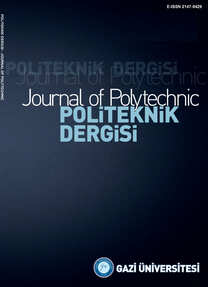Bulanık Hedef Programlama Tabanlı Üç Gruplu Sınıflandırma Problemi Yaklaşımı
Three group classification problem approach based on fuzzy goal programming
___
- [1] Fisher, R.A., “The use of multiple measurements in taxonomy problems”, Annals of Eugenics, 7: 179-188, (1936).
- [2] Smith, C. A., “Some examples of discrimination”, Annals of Eugenics, 13(1): 272-282, (1946).
- [3] Freed, N. & Glover, N.,”A linear programming approach to the discriminant problem”, Decision Sciences, 12: 68-74, (1981).
- [4] Stam, A. & Ragsdale, C.T., “On the classification gap in mathematical programming-based approaches to the discriminant problem”, Naval Research Logistics, 39: 545- 559, (1992).
- [5] Rosen, J.B.,” Pattern separation by convex programming”, Journal of Mathematical Analysis and Applications, 10: 123-134, (1965).
- [6] Mangasarian O., “Linear and Nonlinear Separation of patterns by Linear Programming”, Operations Research, 13: 444-452, (1965).
- [7] Smith, F.W. “Pattern classifier design by linear programming”, IEEE Transactions on Computers, 17(4): 367-372, (1968).
- [8] Grinold, R.C.,” Mathematical programming methods for pattern classification”, Management Sciences, 19: 272- 289,(1972).
- [9] Bajgier, S. M.& Hill, A. V.,” An experimental comparison of statistical and linear programming approaches to the discriminant problem”, Decision Sciences, 13: 604–618, (1982).
- [10] Lam, K.F., Moy, J.W., “An experimental comparison of some recently developed linear programming approaches to the discriminant analysis”, Computers and Operations Research, 24(7): 593-599, (1997).
- [11] Glen, J. J.,” Integer programming methods for normalisation and variable selection in mathematical programming discriminant analysis models”, Journal of Operational Research Society, 50: 1043–1053, (1999).
- [12] Lam, K.F., Choo, E.U., Moy, J.W.,” Minimizing deviations from the group mean: A new linear programming approach for the two-group classification problem”, European Journal of Operational Research, 88: 358-367, (1996).
- ISSN: 1302-0900
- Yayın Aralığı: 6
- Başlangıç: 1998
- Yayıncı: GAZİ ÜNİVERSİTESİ
Analyzing the Environmental Effects of Conventional and Condensing Combi Boilers Using Natural Gas
Halil İbrahim VARIYENLI, Ataollah KHANLARI
Güneş Enerjili Termoelektrik Jeneratörde Pasif Su Soğutmanın Deneysel İncelenmesi
Odunsu Biyokütlenin Pirolizi ile Biyoyağ Üretiminin Modellenmesi: Yapay Sinir Ağları Yaklaşımı
Günay ÖZBAY, Erkan Sami KOKTEN
Evaluation of 3D Modeling Programs For Industrial Design Use
Suna AVCIOĞLU, Semra KURAMA, ERHAN AYAS, Kubra GÜRCAN
Yüksek Gerilim Hatlarındaki Arızalarda Mikroşebekenin Otonom Çalışması ve Arızanın Minimizasyonu
Mustafa BURUNKAYA, Cemal YILMAZ, Furkan ÜSTÜNSOY, Sadık YILDIZ, H.Hüseyin SAYAN, Ercan Nurcan YILMAZ, Mithat BULUT
Termal Depolama Destekli Soğutma Kulesinin Gece Soğutmalı Performans Analizi
Kasım TOPRAK, Kiswendsida Elias OUEDRAOGO
Düşey Düz bir Levhanın Periyodik Salınımlarının Isı Transferine Etkisi
